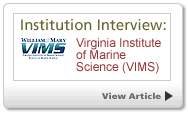Citation analysis shows VIMS in top 1 percent worldwide
The Virginia Institute of Marine Science ranks in the top one percent of institutions worldwide in two fields based on a standard measure of scientific accomplishment—the number of times that colleagues cite an earlier journal article within their own research papers.
The citation ranking, by Thomson Reuters Essential Science IndicatorsSM, shows that VIMS recently entered the top 1% among institutions in the field of Environment & Ecology, and it did so with the highest cite count among new entrants in this discipline. The analysis shows that VIMS was already in the top 1% in the field of Plant & Animal Science.
VIMS Dean and Director John Wells says the ranking "adds quantitative support to the excellent reputation that our researchers have earned among peers for their contributions to the scientific literature."
Essential Science IndicatorsSM tracks the citation records for research articles published in 22 fields, which also include Agricultural Sciences, Biology & Biochemistry, Chemistry, Engineering, Geosciences, Immunology, Microbiology, Molecular Biology & Genetics, Physics, and Space Science.
VIMS entered the top 1% bracket in Environment & Ecology as of September 1, 2009, when Thomson Reuters updated their data to cover the most recent 10-year plus 6-month period, from January 1999 to June 30, 2009.
During that period, VIMS researchers had authored or co-authored 137 papers cited 1,807 times in the field of Environment & Ecology, and 315 papers cited 2,936 times in the field of Plant & Animal Science.
Environment & Ecology
The most highly cited paper in the Environment & Ecology field was a 2006 Science article on the "Impacts of biodiversity loss on ocean ecosystem services" co-authored by Dr. Emmett Duffy, Loretta and Lewis Glucksman Professor of Marine Science at VIMS. The article, which reveals how loss of biodiversity is reducing the ocean's ability to produce seafood, resist diseases, filter pollutants, and rebound from stresses such as over fishing and climate change, has been cited 264 times to date.
Second on the list was a 2006 Nature article on the "Effects of biodiversity on the functioning of trophic groups and ecosystems," also co-authored by Duffy. This article has been cited 135 times.
The third most highly cited paper was a 2003 article in Marine Ecology Progress Series co-authored by VIMS professor Robert "JJ" Orth. Entitled "Critical evaluation of the nursery role hypothesis for seagrass meadows," the paper has been cited 110 times. Orth had several other highly cited papers as well.
Professor Rob Hale had a number of papers atop the citation list describing his work on the source and impacts of flame-retardant chemicals in marine and terrestrial ecosystems. Also highly cited were papers by professors Jesse McNinch, Robert Diaz, Iris Anderson, Jack Musick, John Milliman, Elizabeth Canuel, John Wells, Mike Unger, Deborah Steinberg, and Walker Smith.
Plant & Animal Science
The most highly cited paper in the field of Plant & Animal Science by a VIMS author or co-author was a 2004 review paper in Aquaculture on "DNA marker technologies and their applications in aquaculture genetics." The paper, co-authored by assistant research scientist Jan Cordes, describes the revolutionary impact of genetic markers such as mitochondrial DNA in studies of parentage, inbreeding, and identification of aquaculture species. The paper has garnered 117 citations to date.
Second on the list was a 2000 Fisheries paper on "Protection of marine fish stocks at risk of extinction" by now-emeritus professor Jack Musick. The article has been cited 101 times.
The third most highly cited paper was a 2003 article in Aquatic Microbial Ecology co-authored by VIMS professor Deborah Bronk. Entitled "Dissolved organic nitrogen: a dynamic participant in aquatic ecosystems," the paper has been cited 58 times.
Also highly cited were papers by professors Richard Brill, Jim Bauer, Rochelle Seitz, John Graves, Kim Reece, Walker Smith, Deborah Steinberg, and others.
Graduate Students
Graduate students in the School of Marine Science at VIMS also contributed to the institute's citation success, both as lead authors and co-authors of multi-authored articles.
Ph.D. student Kehui Xu was lead author on "Dam impacts on Yangtze River sediment discharge to the sea: The past 55 years and after the Three Gorges Dam." The article, part of his dissertation, appeared in Water Resources Research in 2006 and has been cited 27 times in the Environment & Ecology category. Xu was advised by professor John Milliman.
Ph.D. student Craig Tobias was lead author on "Nitrogen cycling through a fringing marsh-aquifer ecotone," which appeared in Marine Ecology Progress Series in 2001. It has garnered 24 citations in the Environment & Ecology category. Tobias was advised by professors Iris Anderson and Elizabeth Canuel.
Ph.D. student David Carlini was co-author of "Phylogenetic analysis of cytochrome C oxidase I sequences to determine higher-level relationships within the coleoid cephalopods." The article appeared in the Bulletin of Marine Science in 1999 and has been cited 47 times in the Plant and Animal Science category. Carlini was advised by professor John Graves.
Essential Science Indicators
The Essential Science IndicatorsSM database contains research articles by roughly 4 million scientists at more than 700,000 institutions in 200 nations. The database holds 9 million articles, notes, and reviews, published in roughly 10,000 indexed journals. These 9 million items have received roughly 85 million citations.
A detailed description of the ESI database and the methods by which it is compiled and analyzed is available on-line at http://sciencewatch.com. Also available on the site is an in-depth interview of highly cited VIMS researchers by Thomson Reuters' editorial coordinator Jennifer Minnick.

